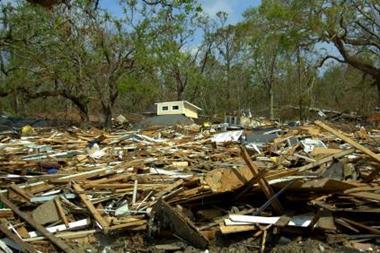No one can predict the future, so we cannot know for sure what catastrophes the world is going to throw at us, but it is our job to fear the worst and prepare as much as possible for it. At Lloyd's, this is the principal role of the exposure management team, and we are further strengthening the market's ability to prepare for major losses.
A key tool we use to do this is our realistic disaster scenarios (RDS). These set out a number of hypothetical disaster situations, giving as much detail as possible. We then ask the insurers who trade at Lloyd's to look at their books and ensure that, if the disaster were to happen, they would not be over-exposed.
RDS are an invaluable way to help ensure that the market is prepared for disaster, but it is worth stressing that they only one part of an overall framework of disciplined underwriting for profit. They are part of the equation, not the answer.
The RDS enable us to look across the market for any vulnerability. As the global risk environment changes, it is vital that we keep them up to date. In recent years we have done a lot of work to develop and improve our RDS to reflect better the changing nature of the world and its new, emerging risks.
For example, in 2005, we introduced an RDS for a $60 billion hurricane hitting the Gulf of Mexico - $10 billion offshore, $50 billion onshore. Some people in the market said that a loss of this magnitude would never happen. Hurricane Katrina proved them wrong. The market was able to withstand Katrina and her sisters last year, but without that RDS, Lloyd's overall financial result could have been much worse. So, in 2006, we increased the scope of the RDS once again, asking the market to model for a $100 billion hurricane. The scenarios have truly to stretch the market. If not, they are pointless.
We have also introduced new windstorm scenarios for the northeast coast of the United States and the Carolinas. We have asked the market to model for a hurricane hitting, among other places, the states of New York and New Jersey, causing $65 billion in losses, along with a windstorm in South Carolina causing a further $30 billion in claims.
Not just hurricanes
Hurricanes are just one of a range of scenarios we put to the market. Others include two ships - a tanker and a cruise ship - colliding in Alaska, two planes colliding above a major city and a Japanese earthquake leading to an industry loss of $50 billion. We also have a windstorm scenario set in Europe costing $30 billion.
We have also introduced a new scenario for aviation terrorism. Events such as the thwarted terrorist attacks on trans-Atlantic aircraft in August 2006 have highlighted the continued attraction of airports and planes as targets for terrorism. This new RDS is designed to give Lloyd's insight into the likely loss implications for syndicates which might result from a number of specified terrorist attacks. We set out three scenarios:
- Attacks over sea on five large aircraft resulting in complete destruction and loss of life.
- Bomb attacks at a single airport on five aircraft. Each bomb causes total destruction of the targeted aircraft and partly destroys the two neighbouring aircraft, so 15 planes are damaged in total. It affects passengers and crew, and there is loss of life among airport staff.
- Bomb attacks on five aircraft, but this time each is at a different airport.
Terrorism is a real threat, and it is important that we feel comfortable that our insurers are capable of covering a major attack.
The loss estimates that we get from the RDS exercise give us a valuable stress test of syndicates' exposure to these catastrophes and large loss events. They are a vital tool for us, and we will continue to update them year on year, incorporating the lessons that we learn from each big event.
While the internal monitoring provided by the RDS process is valuable for syndicates, most of them also use commercially available catastrophe models to compile a more complete picture of their disaster loss potential. Such models have recently been overhauled to reflect lessons learned from the 2005 hurricanes, when some insurers' faith in their reliability was tested. In part, however, this was because of their over reliance on a single model.
Time for open source
To make it easier for insurers to access multiple models, I believe that the time is right for the industry to develop the concept of what is called open source risk modeling. This basically involves allowing an insurer to choose from a suite of hazard models, and a range of data.
An open source platform would allow insurers access to a number of different models, some from traditional loss modelers and some from the wider academic community. This would help them to have a far more reliable and balanced view of the risks associated with a catastrophe and a greater understanding of the uncertainty involved. Considering the vast amounts of money at stake, it makes sense to look at what a range of people are saying, and not just have blind faith in one.
Nor should insurers be restricted to data from modelling firms. The three major catastrophe modelling agencies, are currently covering peril territories across the world, and resources are increasingly stretched. There is also a huge amount of academic and government research which the industry should be able to access, as well as use to supplement existing models.
With the world getting riskier, the insurance industry needs as much information as it can get. At the end of October 2006, Lloyd's published a second report on climate change: What next on climate change? In it, we announced a new team at Lloyd's which will gather expertise from around the market and beyond, and work to ensure that every Lloyd's firm can prepare for and manage the growing risks involved.
In our first report on climate change, published in June 2006, we looked at the scientific research available and drew some key conclusions. Climate change is happening faster than we thought it would, and investment in research and changes in behaviour are both long overdue in our industry. Insurers must act now to understand and actively manage risks from emerging threats, such as more extreme weather and rising sea levels.
The severe hurricanes of the past two years are the most obvious example of the potential hazards. Scientists generally agree that we are currently in an active phase of Atlantic hurricane activity. Hurricanes are likely to happen more often, and may be more severe over the next 10 to 20 years and possibly much longer, if climate change occurs in the way some scientists expect.
Against this backdrop, good exposure management is ever more important for our industry. The increased severity and frequency of hurricanes, the rising value of insured property and the growing population in exposed areas make this very clear.
This is why Lloyd's has expanded its exposure management team to look specifically at emerging risks such as climate change. We cannot predict the future, but we can learn from the past.
- Paul Nunn is head of exposure management for Lloyd's.
Website: www.lloyds.com



















